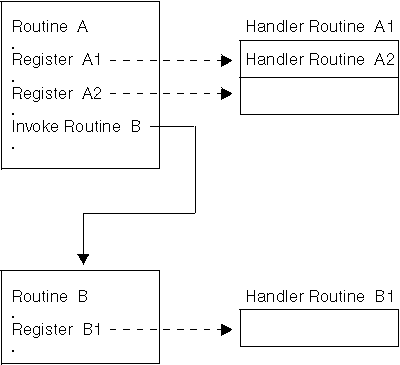Invoking condition handlers
- Debug tool
- If you have invoked a debug tool using the TEST runtime option or the CEETEST callable service (see z/OS Language Environment Programming Reference), the debug tool gains control when a condition occurs. Unless a condition is promoted and is passed through the stack again for additional condition handling, a debug tool is invoked only once per stack.
- User-written condition handler
- User-written
condition handlers are routines that you supply to handle specific
conditions that might arise in the runtime environment. As shown in Figure 1, a LIFO queue containing zero
or more user-written condition handlers
is associated with each stack frame. A different queue exists for
each stack frame. For example, if routine A calls routine B, there
is a new queue associated with the stack frame for routine B. Figure 1. Queues of user-written condition handlers

User-written condition handlers are registered on a stack frame-by-stack frame basis using the CEEHDLR callable service. A call to CEEHDLR from a given routine adds a user-written condition handler onto the queue for the stack frame associated with that routine. Registering a condition handling routine using CEEHDLR implicitly requests Language Environment to pass control to this routine when a condition occurs. For example, you could call CEEHDLR to register two user-written condition handlers for the same stack frame, one that handles floating-point underflow conditions and another that handles floating-point divide conditions.
The most recent user condition handler registered using CEEHDLR is the first to be invoked by Language Environment. Note that you could also register a single user condition handler to handle both of these conditions.
The user-written condition handlers can respond to a condition in any of the ways described in Responses to conditions.
User-written condition handlers are given a chance to handle a given condition before the language-specific condition handling semantics described in "Language-specific condition handling semantics" take effect.
- Language-specific condition handling semantics
- If language-specific
semantics are established within a stack frame, they are honored.
Of course, the language-specific handling mechanisms act only on those
conditions for which the language has a defined action. The language percolates all
other conditions by passing them on to the next condition handler.
If a condition is unhandled after the stack is traversed, default language-specific and Language Environment condition semantics take over.